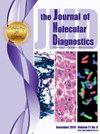Improving Specificity for Ovarian Cancer Screening Using a Novel Extracellular Vesicle–Based Blood Test
IF 3.4
3区 医学
Q1 PATHOLOGY
引用次数: 0
Abstract
The low incidence of ovarian cancer (OC) dictates that any screening strategy needs to be both highly sensitive and highly specific. This study explored the utility of detecting multiple colocalized proteins or glycosylation epitopes on single tumor-associated extracellular vesicles from blood. The novel Mercy Halo Ovarian Cancer Test (OC Test) uses immunoaffinity capture of tumor-associated extracellular vesicles, followed by proximity-ligation real-time quantitative PCR to detect combinations of up to three biomarkers to maximize specificity, and measures multiple combinations to maximize sensitivity. A high-grade serous carcinoma (HGSC) case-control training set of EDTA plasma samples from 397 women was used to lock down the test design, the data interpretation algorithm, and the cutoff between cancer and noncancer. Performance was verified and compared with cancer antigen 125 in an independent blinded case-control set of serum samples from 390 women (132 controls, 66 HGSC, 83 non-HGSC OC, and 109 benign). In the verification study, the OC Test showed a specificity of 97.0% (128/132; 95% CI, 92.4%–99.6%), a HGSC sensitivity of 97.0% (64/66; 95% CI, 87.8%–99.2%), and an area under the curve of 0.97 (95% CI, 0.93–0.99) and detected 73.5% (61/83; 95% CI, 62.7%–82.6%) of the non-HGSC OC cases. This test exhibited fewer false positives in subjects with benign ovarian tumors, nonovarian cancers, and inflammatory conditions when compared with cancer antigen 125. The combined sensitivity and specificity of this new test suggests that it may have potential in OC screening.
使用基于细胞外囊泡的新型血液检验提高卵巢癌筛查的特异性--训练和验证队列中的表现。
卵巢癌(OC)发病率低,因此任何筛查策略都必须具有高灵敏度和高特异性。本研究探索了从血液中检测单个肿瘤相关细胞外囊泡 (EV) 上多个共定位蛋白或糖基化表位的实用性。新型 OC 检测试剂盒采用免疫亲和法捕获肿瘤相关的 EVs,然后进行邻近连接 qPCR,检测多达三种生物标记物的组合,以最大限度地提高特异性,并测量多种组合,以最大限度地提高灵敏度。利用来自 397 位女性的 EDTA 血浆样本组成的高级别浆液性癌(HGSC)病例对照训练集来锁定测试设计、数据解读算法以及癌症与非癌症的分界点。在 390 名女性(132 名对照组、66 名 HGSC、83 名非 HGSC OC、109 名良性)血清样本组成的独立盲法病例对照组中,对其性能进行了验证,并与 CA125 进行了比较。在验证研究中,OC 检验的特异性为 97.0%(128/132;95% CI:92.4%-99.6%),HGSC 敏感性为 97.0%(64/66;95% CI:87.8%-99.2%),AUC 为 0.97(95% CI 0.93-0.99),还检测出 73.5%(61/83;95% CI:62.7%-82.6%)的非 HGSC OC 病例。与 CA125 相比,该检测方法在良性卵巢肿瘤、非卵巢癌和炎症患者中的假阳性率较低。这一新检测方法的灵敏度和特异性表明,它在卵巢癌筛查中具有潜力。
本文章由计算机程序翻译,如有差异,请以英文原文为准。
求助全文
约1分钟内获得全文
求助全文
来源期刊
CiteScore
8.10
自引率
2.40%
发文量
143
审稿时长
43 days
期刊介绍:
The Journal of Molecular Diagnostics, the official publication of the Association for Molecular Pathology (AMP), co-owned by the American Society for Investigative Pathology (ASIP), seeks to publish high quality original papers on scientific advances in the translation and validation of molecular discoveries in medicine into the clinical diagnostic setting, and the description and application of technological advances in the field of molecular diagnostic medicine. The editors welcome for review articles that contain: novel discoveries or clinicopathologic correlations including studies in oncology, infectious diseases, inherited diseases, predisposition to disease, clinical informatics, or the description of polymorphisms linked to disease states or normal variations; the application of diagnostic methodologies in clinical trials; or the development of new or improved molecular methods which may be applied to diagnosis or monitoring of disease or disease predisposition.

 求助内容:
求助内容: 应助结果提醒方式:
应助结果提醒方式:


